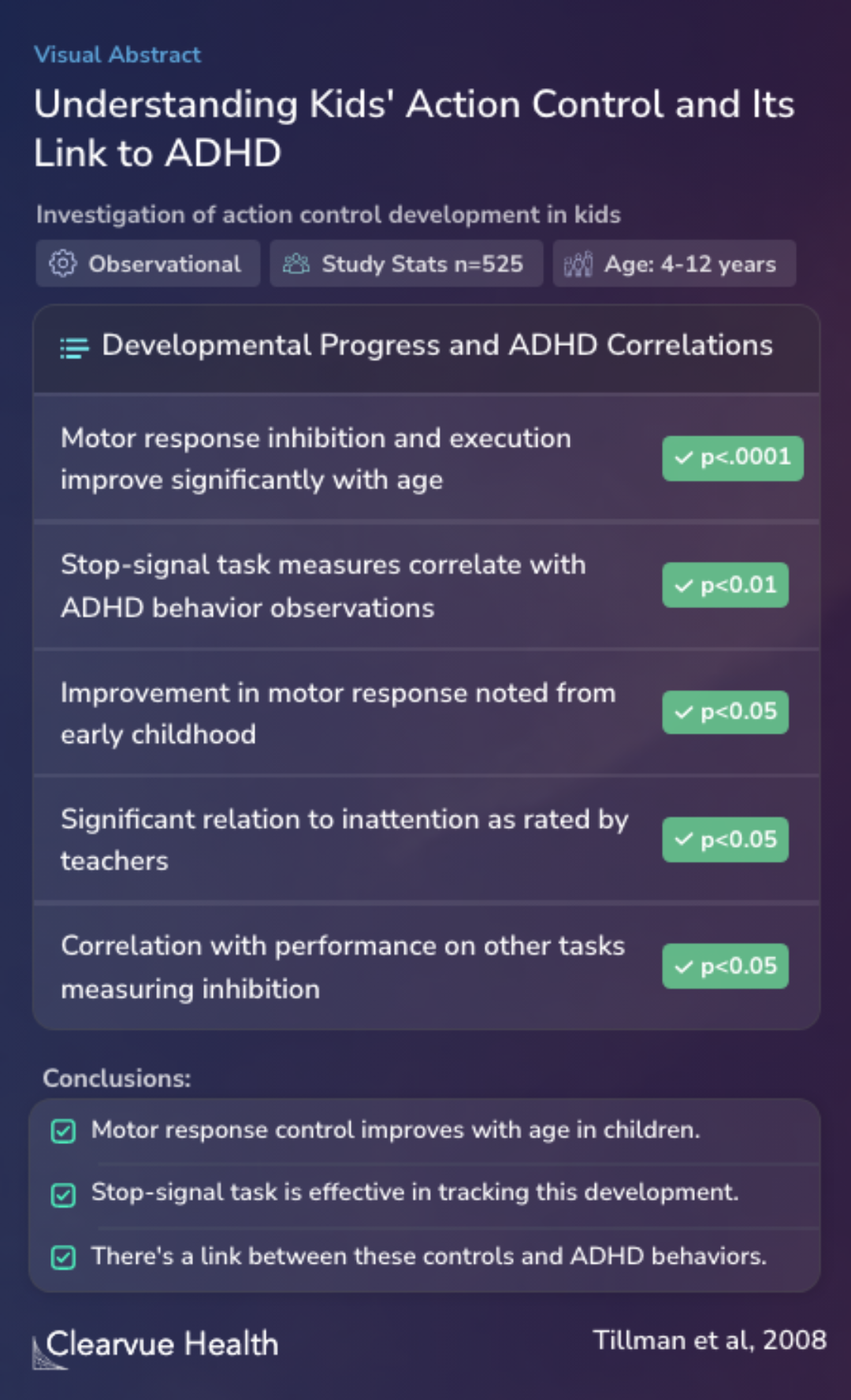Motor response inhibition and execution in the stop-signal task: development and relation to ADHD behaviors
Understanding Kids' Action Control and Its Link to ADHD
Carin M Tillman, Lisa B Thorell, Karin C Brocki, Gunilla Bohlin

Objectives
The main goal of this research was to look into how kids from ages 4 to 12 get better at starting and stopping their actions on cue, using a special test known as the stop-signal task. This study, involving 525 children, aimed to fill in the gaps in what we know about how these abilities relate to behaviors seen in ADHD (Attention-Deficit/Hyperactivity Disorder) in kids who don't have this diagnosis. By doing so, the researchers hoped to get a deeper understanding of how these start-stop actions connect with other tasks that require a child to control their impulses and actions.
The main aim of this study was to investigate the developmental course of motor response inhibition and execution as measured by the stop-signal task in a population-based sample of 525 4- to 12-year-olds. A further aspiration of the study was to enhance the limited knowledge on how the ...
Methods
In terms of methods, while the abstract doesn't lay out the specifics, it's understood that the study observed a large group of kids, 525 to be exact, ranging in age from 4 to 12 years. The approach taken to gather data was through observation, focusing on how these children managed their actions, particularly in starting and stopping tasks, to learn more about their development in these areas.
Not explicitly stated in the abstract; details on methods may include the design, sample, and measures used but are not directly provided.
Results
The findings from the study indicate a clear growth in the children's ability to control their movements — both in starting and stopping them — as they get older. A noteworthy point is that this improvement is particularly evident from the late preschool period, around age 5. Furthermore, the two main ways the stop-signal task measures this ability — how quickly they can stop an action they've started and how often they're able to stop when they need to — were closely linked to what teachers said about the kids' attention levels. These measures also showed a connection with how well the children did on other tasks that test their ability to control impulses and actions.
Our results showed that the ability to inhibit as well as to execute a motor response as measured by the stop-signal task improved with age during childhood. Of specific interest are the findings suggesting that this task captures the development of motor response inhibition in the late ...
Conclusions
This research adds valuable information to the relatively limited understanding of how young children develop the ability to control their physical actions, particularly in stopping and starting tasks. The stop-signal task, as used in this study, proves to be a useful tool in tracking these abilities as they evolve in children. Moreover, the study highlights a significant link between these control mechanisms and behaviors typically associated with ADHD, suggesting that this task could be particularly useful in identifying such behaviors in a general population of children.
The data provided by this study have thus contributed to the scarce knowledge on early development of motor response inhibition, as well as suggested that the stop-signal task may be a valuable tool for capturing deficient motor response inhibition in ADHD behaviors in normal samples.
Key Takeaways
Context
In the broader discussion about ADHD, it's important to understand the concept of response inhibition, which acts like a mental brake system, allowing individuals to stop their actions or thoughts. This ability is crucial, especially for those with ADHD, who may struggle with impulsivity, affecting their social and academic lives. Research, including this study, highlights that individuals with ADHD might show less brain activity in areas responsible for stopping actions.
Another study by Alderson and colleagues in 2007 adds to this by showing that children with ADHD not only have trouble stopping their actions but also display slower reactions and more variability in their responses, pointing to broader attention issues beyond just impulsivity. These insights emphasize the complexity of ADHD, involving challenges in both action inhibition and attention regulation, thereby underscoring the importance of understanding these mechanisms in both clinical and normal development contexts.